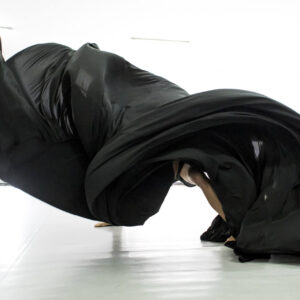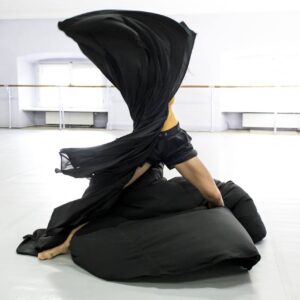Fearless - Gosia Mielech in a solo performance
"FearLess" - chor. Gosia Mielech - DanceLab
I must not fear fear is the mindkiller
On October 22, at 19.00, the Polish premiere of the solo performance entitled "FearLess" by Gosia Mielech - a dancer, choreographer, dance teacher, Gaga teacher, associated with the original artistic project DanceLab.
The title is an English neologism, combining the words fear and less, which in this juxtaposition can mean "fearless" or "no fear". This directs the viewer towards the first semantic layers of the performance. It is the physical considerations about fear that are the leading axis around which the stage reality is built. The artist did not take shortcuts and did not follow in her project to show it only in the context of the primary emotion, which she undeniably is. She took a step further. Through an in-depth analysis of the phenomenon and interviews conducted for the performance,
Gosia Mielech showed fear as a common, social semantic construct that can condition the functioning of each of us, because it is, like the language of the movement, through which the artist communicates with us, culturally universal. Another universal present in the artist's project is the archetype of the hero. The author perversely treated her deliberations as an excuse to use pop culture references to superheroes, known to a wider audience from the film production of the "Marvel" and "DC" film universes. This can be seen, for example, in the well-designed, by Kata Kwiatkowska, stage costume, which may be associated with Wonder Woman (a character played by Gal Gadot, in the 2017 film of the same title, directed by Patty Jenkins). The choreographer thus created a dramatic and semantic paradox,because superheroes aren't likely to be afraid. And this is the foundation for further considerations.
It is also worth mentioning the place where the show "FearLess" was presented to the audience. The scene of the Poznań "Pavilion" turned out to be an exceptionally intimate space and allowed for close contact of the audience with the artist, who used it very efficiently, interacting with the audience. The chairs were arranged in a U-shape on three sides. The traditional model of the stage was broken, where the artist plays mainly with the front of the audience. Personally, I really like this perspective. Thanks to this, one has the impression of an intensified three-dimensionality of the performing artist, plus you can see details that under normal conditions could escape attention.
After taking their seats, the audience's attention shifted to the sheet of black cloth that lay in the center of the stage. It was also the main prop used throughout the performance. The presence of smoke and precisely directed lighting gave the impression of an illusion. The minimalist set design absorbed colors, was wrinkled and aroused anxiety from the very beginning. It was associated with the fear it symbolized. At this point, it is necessary to mention the excellent use of art and image manipulation in "FearLess", which is not typical for dance performances. Although the use of such material is not surprising in the theater, in Gosia Mielech's performance it has become a new form, evoking film scenes associated with the materialization of evil with the use of special effects. The emergence of music - outstanding and mesmerizing,An electronic soundtrack by Anna Suda made the object come to life. The artist who, judging by the reactions, actually went unnoticed by most of the viewers, lay under him all the time.
The first scene follows the convention of the artist's physical struggle with "black matter". On the one hand, the sheet stuck to the artist's body like a parasite, and on the other, there were moments when the dancer consciously animated her. The clear, dynamic, even animalistic movement in contrast to the rather delicate appearance of the show's creator attracted attention. The artist precisely hit the material, which effectively and repeatedly "exploded". The very efficient handling of a difficult prop, which can be described by the choreography of the object, attracted attention. The dancer dynamically changed her position in the stage space, all the time keeping the attention of the audience, which is a matter worth noting in the context of the entire, perfectly composed performance. This was helped by a lot of changes in the pace of movement and in the artist's cinema,which, in turn, translated into building dramatic tension. At one point, the artist dressed the cloth like a boxing robe with a hood, in which the players usually go out into the ring. The dance reflected the preparation for the fight. The dancer made quick blows into the air. It was a surprise to attach the sheet to the artist's costume like the cloaks so typical of superhero costumes. From that moment on, the performer clearly articulated each movement, which led to her taking control over the prop and separating it. Then, the material, like a gift, was handed over to a random person in the audience and hidden under the chair. This gesture can be read as an exemplification of the fact that each of us has our own "black cloth", kept symbolically hidden. Fear, fears and fears with which he struggles internally.Fighting with yourself.
The text layer in English was also audible to the audience. The statements did not form a logical narrative. A male voice was repeating the phrases
"my biggest fear is myself",
"nothing scares me more than me".
I believe that the formal procedure applied in this case is an appropriate solution and consistent with the concept of the performance. The narrator's low voice can be read as everyone's universal inner voice, "everyman", or our ego. It can also be associated with an internal monologue repeated by a superhero who cannot be afraid.
The scene in which the artist gets rid of the cloth opens a new chapter in the composition. We hear words from the off-screen repeated mechanically. Words are deliberately cut off and syllables escape our perception, which is further changed to fully audible utterances.
"I must not fear",
"fear is a mindkiller",
"fear is a little death that brings a total obliteration". which causes total destruction),
"I will face my fear".
Deliberate repetitions created a mantra which the figure on the stage choked in a way. An interesting dramatic trick was the use of the voice. The above-mentioned words and sentences, as if in passing, escaped / popped out of the dancer's mouth. This organic impulse gave birth to a further choreography in a strong physical dance style. It is impossible not to notice the exceptional, almost virtuoso performance qualities of Gosia Mielech, characterized by precision on the one hand, and animalism and internal "explosive power" on the other, evoking associations with Ohad Naharin's performances. It is worth mentioning here that the artist lived in Tel Aviv for a year and a half, where, among others, under the watchful eye of Naharin and other creators associated with Batsheva Dance Comapany, she implemented the "Gaga Teacher's Training Program". Particular attention was paid to working with details,understood here as minor but significant elements of the choreography.
It includes for hand positioning and repetitive gestures, adding a choreographic flair. The facial expressions of the dancer, which emphasized her psychophysical states, also played a very important role in the performance. Quick, uncorrelated blinks of eyes and involuntary grimaces added to the authenticity of the characters on stage. They suggested how much could be read from a face on the basis of unspeakable emotions. Then the dance began, through which the artist took us on a journey through the meanders of unconscious, physical sensations and sensations, oscillating around the main theme of the project. The skillfully composed choreography attracted attention. The use of counterpoints in the form of pauses and surprising changes in the pace of the performance did not allow the audience to lose their attention. The artist became a superhero,which she emphasized through the characteristic gestures of raising her hands and body posture, to change the dynamics of movement again and show uncertainty and fear in a moment. The performance ends with a peculiar composition bracket. The artist put the sheet back on, but this time she was in control of the situation. She didn't fight the black material, but she was in full control of it. After all, fear is a natural emotion that we should not give up. However, it is worth learning to live in harmony with it on the principle of symbiosis, not antagonistic relations.which we should not give up. However, it is worth learning to live in harmony with it on the principle of symbiosis, not antagonistic relations.which we should not give up. However, it is worth learning to live in harmony with it on the principle of symbiosis, not antagonistic relations.
"FearLess" is a spectacle that stands out on the Polish stage and is worth seeing for several reasons. Certainly for the virtuoso performance qualities of Gosia Mielech, who has grown into one of the most interesting personalities of Polish dance. The audience's attention is also drawn to the trance, authorial music of Anna Suda and the excellent visual setting of the performance, which is complemented by a superhero costume designed by Kata Kwiatkowska, as well as a sensational animated prop and precise lighting design. Above all, the creator of "FearLess" speaks very clearly about something important and makes you reflect on our functioning.
After all, stress, so often indicated by various milieus as the killer of civilization, is the twin brother of fear. It is its second, even synonymous face, it is a reaction to fear. From an artistic point of view, the key is the fact that the creator managed to avoid the trap of an unbearable, enlightened, moralizing tone, in the style of "I'll show you how to live better". The performance provokes you to look inside yourself and search for individual answers to the question: do I have the courage to fight not with myself, but for myself?
Marek Debłużny
The Theater Journal
4 December 2019



